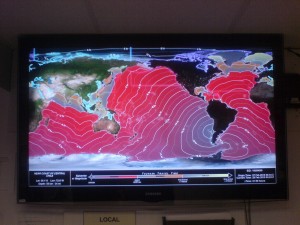Social Media Adds to Torrent of News
Social media adds to torrent of news
Online social media sites and radio and television airwaves were awash with tsunami information by the time Civil Defense sirens rousted isle residents to news of a tsunami warning. Sites such as Twitter and Facebook were both sources of, and conduits for, information from traditional media outlets as well as individual users.
In addition to Erika Engle’s account for the Honolulu Star-Bulletin, check out an excellent first-person account by Brian Shiro:
The tsunami warning system as we know it today was established in the 1950s and 60s during the era of teletype. It is very hierarchical whereby the tsunami warning centers send messages to local government and emergency management officials who then mobilize their respective constituencies. However, the average person today has access to so much more information compared to people from a generation ago. Anyone can get tsunami warnings via PTWC’s website, RSS feeds, email or SMS subscriptions. A recent PEW survey has shown that more Americans get news from social media and the internet than any other source.
This implies that the top-down approach to tsunami warning may be less effective today than it once was, so I personally feel that the tsunami warning system needs to adapt to today’s reality of instant information availability.
Photo from Astronaut for Hire, used with aloha.


